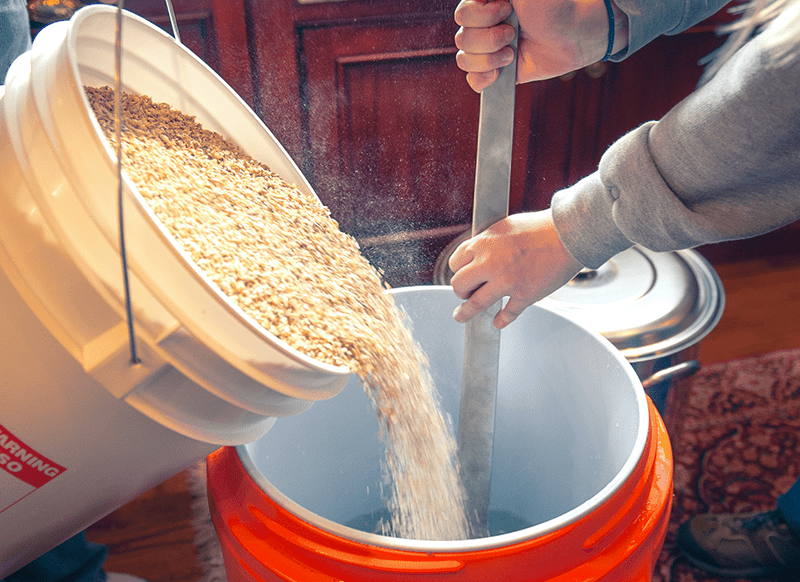 If you’re a homebrewer, you may have heard about mash efficiency in the brewhouse. But what is it and why does it matter?
If you’re a homebrewer, you may have heard about mash efficiency in the brewhouse. But what is it and why does it matter?
Mash efficiency is a measurement of the percent of available sugars obtained through the mashing process. Brewing malt contains a certain amount of complex sugars, and the percentage which are extracted in a mash give us the mash efficiency. By improving mash efficiency, one can use less malt and save a little money, but the real value for the homebrewer is the ability to accurately predict the amount of malt needed when formulating a beer recipe.
Calculating Mash Efficiency
Later we’ll get into improving mash efficiency, but for now, here is one method for calculating mash efficiency, by using the gravity measurement of points per gallon (PPG):
Suppose that we use 10 pounds of two-row malt in a mash, and that this malt has a gravity rating of 1.037, or 37 points. After the mash and the sparge, we end up with 5 gallons of wort. If we were to extract all of the sugars from that malt (achieving 100% efficiency), the resulting wort would have a total of 370 points (37 points * 10 pounds). Divide by 5 gallons, and the resulting pre-boil gravity would have 74 points per gallon, or a gravity of 1.074.
But even the most efficient mashing processes can’t extract all of the sugars from the malt. The typical mash efficiency of a homebrewer will be in the ballpark of 60-80%, though this number can vary quite a bit depending on the brew, the type of homebrewing equipment being used, and number of other factors.
Continuing with the example above, suppose that the actual measured gravity of the wort when taken by a hydrometer is 1.050. We simply divide the measured gravity by the potential gravity to calculate the mash efficiency:
50 / 74 = 67.6%
 The challenging part of calculating mash efficiency is that we tend to brew with multiple types of malts, often with different extract ratings. As a result, calculations become a little more complicated.
The challenging part of calculating mash efficiency is that we tend to brew with multiple types of malts, often with different extract ratings. As a result, calculations become a little more complicated.
Suppose we mash the following grain bill and end up with 5 gallons of wort:
- 8 lbs. two-row base malt (1.037)
- 2 lbs. Munich malt (1.033)
- 1 lbs. Crystal 60L malt (1.034)
Our total extract potential is:
[(37 * 8) + (33 * 2) + (34 * 1)] / 5 = 79.2
If our measured pre-boil gravity is 1.060, then our mash efficiency is calculated in this way: 60 / 79.2 = 75.8%
That’s actually a pretty good efficiency!
Improving mash efficiency
Beginning all-grain brewers may find that their mash efficiency is in the 50-60% range. With consistent note-taking, mash efficiency can be improved in the following ways:
- Better grain crush
 – If grain isn’t crushed enough, it will be difficult to extract the sugars from the grain. On the other hand, if the grain is crushed to much, the brewer risks a stuck sparge. It’s important to set the grain mill to get an appropriate crush.
– If grain isn’t crushed enough, it will be difficult to extract the sugars from the grain. On the other hand, if the grain is crushed to much, the brewer risks a stuck sparge. It’s important to set the grain mill to get an appropriate crush. - Improved mash procedures (appropriate pH, temperature, water-to-grain ratio, length of mash)
- Appropriate water chemistry
- Improved sprage techniques – A slower sparge (30-60 minutes) will rinse more sugars from the mash than a fast one. Sparging with too much water will decrease your mash efficiency.
All of the above are effective ways to improve your mash efficiency. Get a handle on them and you’ll get more sugar from your grains.
Do you calculate the extract efficiency when you homebrew? Has your mash efficiency been improving?
—–
David Ackley is a beer writer, brewer, and self-described “craft beer crusader.” He holds a General Certificate in Brewing from the Institute of Brewing and Distilling.

OK, but how do I know the gravity of grain malts? I’ve never seen that info published anywhere.
Richard, below is the link to a chart that will provide the potential specific gravity of each malt. However, keep in mind that the actual gravity will depend on the efficiency of mashing process.
Grain List
http://beersmith.com/Grains/Grains/GrainList.htm
Thanks for this excellent explanation. What about Conversion efficiency, I’ve read that you have to include grain absorption and dead space water volumes. So mash efficiency and conversion efficiency are different I guess.